Episode #9: The Inside Story of HubSpot’s Content Marketing Strategy
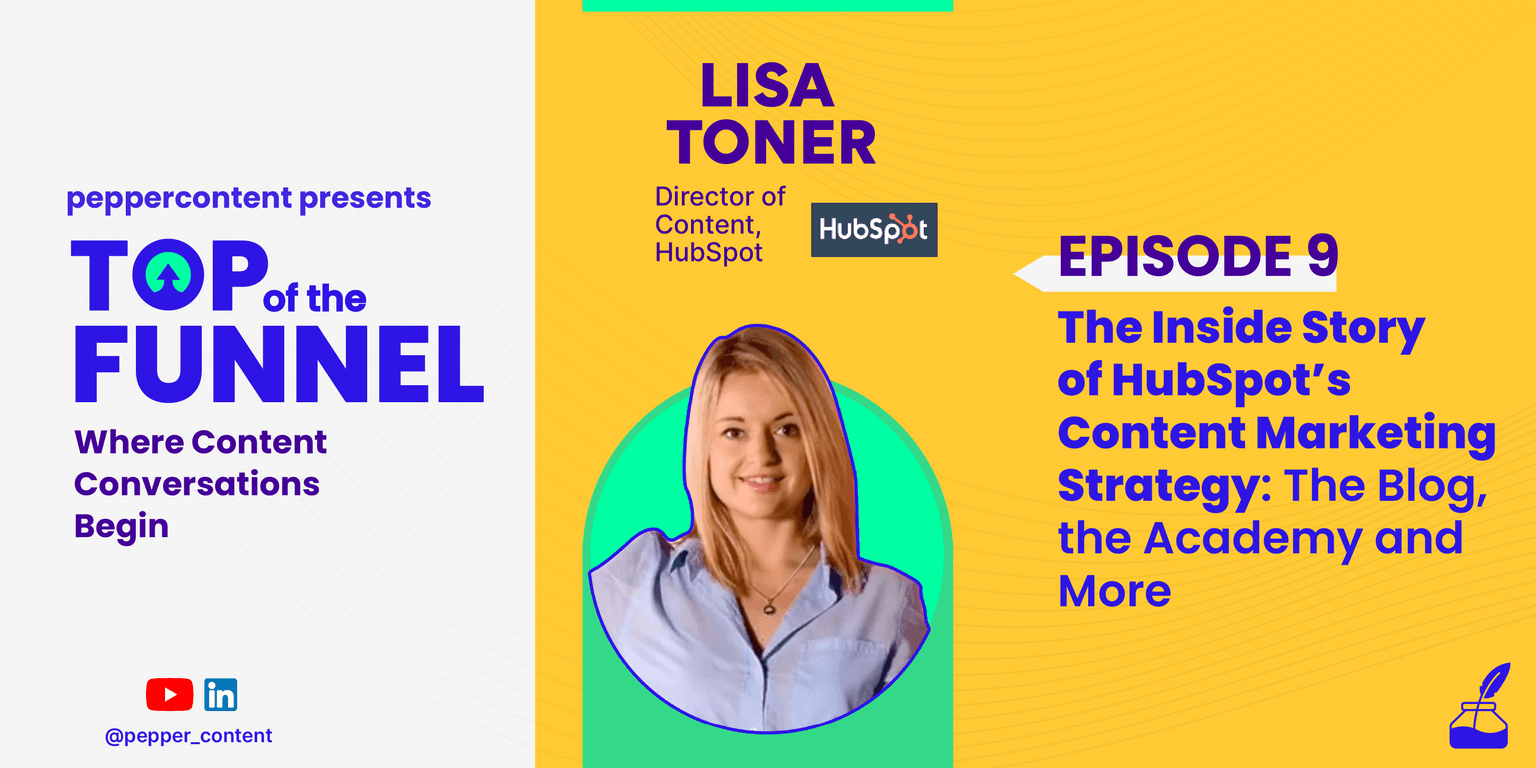
A few names have become synonymous with content marketing, and HubSpot is one such organization. With reams of valuable content out there on their blog, disseminated for free via the HubSpot Academy and more, HubSpot has almost been the school that every aspiring content marketer has attended virtually. In other words, Hubspot is a cloud-based customer relationship management platform, curated for sales and marketing teams to grow their businesses. It helps them to optimize their inbound marketing strategy to get more qualified leads.
In this episode of Pepper Content’s Top of the Funnel series, Natasha Puri, Content Marketing Lead at Pepper, caught up with the Director of Content at HubSpot, Lisa Toner. She has been with Hubspot for over eight years and had a key role to play in Hubspot’s growth in the past few years.
Natasha Puri: Hello everyone. Welcome to Top of the Funnel, the series where conversations about content begin. Our guest today is Lisa Toner, the Director of Content at Hubspot. This chat promises to be very informative and insightful as Lisa takes us through Hubspot’s content marketing teams, their strategies, and leaves valuable informative nuggets for businesses to make use of. The Hubspot is almost synonymous with content marketing. They have done a remarkable job in bringing inbound leads, prospective customers, and convertible leads to businesses. Lisa has joined us from Dublin.
Let us start from the beginning. Can you talk us through what your team looks like? How does the content marketing structure look like at HubSpot?
Lisa Toner: We’re fortunate at HubSpot to have grown into such a big team. We’ve centralized the core functions of content marketing into specific teams. As the director of content at HubSpot, I oversee all content. I look after the blogging, YouTube podcasting, demand generation, and distribution teams. Outside of my realm, we also have an SEO team and an email marketing team, but we’re all very much interconnected.
I believe that a blog team is the most interesting part of any company. If we begin with content marketing, the blog is the first place to start. We currently have a big team. We’ve got about 14 writers across four different blog properties. And then we’ve got an editor overseeing each blog property and a manager overseeing them.
And we also have a team that is dedicated to the conversion of blog traffic into content leads for the business. That’s a team of one at the moment. So, this person is looking at which blog posts are generating the most traffic and leads, what type of content should be created for more conversion and leads, and documenting the impact and strategizing for future blog posts. This approach has proven helpful for all of us at HubSpot.
We started with our Youtube team last year. We have a strategist, who looks at the channel as a whole and answers questions like how to optimize the channel, what type of content does it need to grow, and so on. We have one scriptwriter, who is writing scripts and is the on-air talent, and we have a whole production team living under the video. They are not my team, but we work in very close collaboration. And we’re also hiring another scriptwriter and manager for the YouTube channel.
Then we have podcasting. We’ve just launched a podcast network, the team is very small at the moment, but it will grow in time. We also have several people, who look after distribution across all these channels. They answer questions like how to grow traffic on the blog, how to convert leads, how to increase the podcast downloads, how to boost views on Youtube, and so on. They’re looking at optimizing growth.
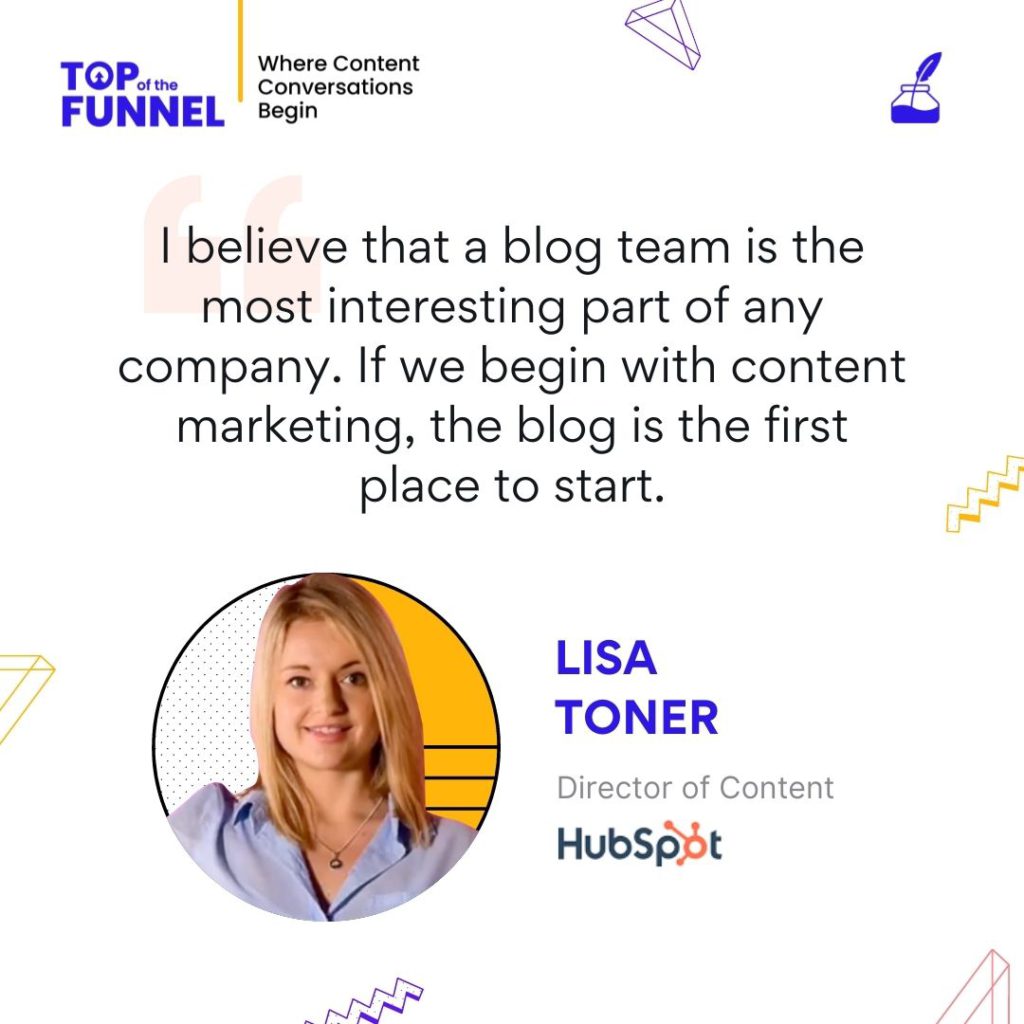
Natasha Puri: Do you see any sense in repurposing the blogs into video content, or is that completely different?
Lisa Toner: Yes, there are ways to repurpose it. And we’re experimenting with that at the moment. There are popular topics on the blog, that are taking off, and it indicates that there is room for a video to be produced on that same topic, or even a series of videos to help the learner go deeper into the topic. Then, we will embed the YouTube videos that we create on those blog posts. One gets more views on YouTube videos by having the blog readers see that video. Also, by embedding the video on the blog posts, you’re increasing your rankings in Google, which ultimately gets more people to your content. Videos are more likely to rank in the video carousel on the Google search results pages. So, more people can find that content.
Natasha Puri: What have been the biggest challenges in creating a result-oriented approach to content marketing over the years and how have you overcome them?
Lisa Toner: Most content creators are not much analytical. When you have creative people creating great content, they can feel a bit stifled by having a target over their heads. But, the target makes you deeply analyze what makes great content. So, it actually helps creators. For example, you can look at a YouTube video and see where people are dropping off. If you are looking at the analytics, you can question where did you lose people. What did we say here? What was the visual? Let’s change that and test it. So using the data, you can actually help the creators make even better content. But taking a step back from there, looking at the overall targets of the blog, the biggest challenge would be data-driven.
Search engine optimization is how you grow a blog effectively at scale. So we have built our entire editorial strategy around keywords and topics with huge demand. Our strategy is to acquire as much search volume as possible on our blog. We’ve set our targets based on the monthly search volume that we’ve already captured and what we expect to capture over time based on those keywords.
However, as soon as Google reduces an algorithm update or changes how they surface up results in those results pages, which they’ve been doing a lot recently, you start to see a really big impact on your overall numbers.
But, that is out of your control. The biggest challenge is that if you are not generating much traffic, your team’s morale is definitely affected. They are starting to believe, ‘I’m working really hard. I’m doing what I always did. But it’s not working anymore. And I can’t control what Google does with their UI.’
This has definitely been one of the biggest challenges. To overcome this, we’ve revised our goals. Our goals were based on how Google used to do things and you update them to reflect how it has been done that day. We have been repeating over and over again to our writers, to the blog team, that this is not a reflection of their execution, or of the quality of their content. This is outside of our area of control and they should not feel like it’s a direct result of anything that they’ve done. And that message needs to be strong and repeated from our leadership, not just from their managers to keep that morale high.
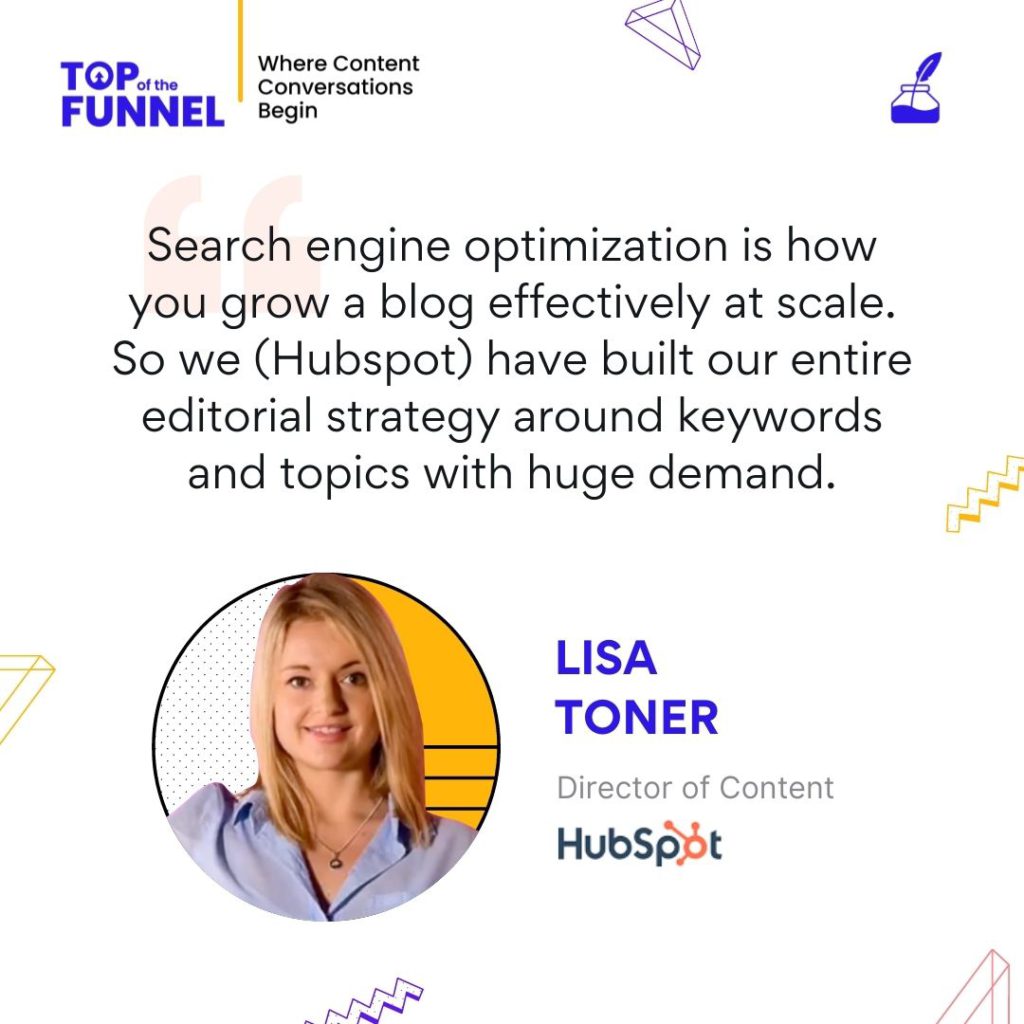
Natasha Puri: How long does it take for you to see an impact in terms of page ranking and traffic after you’ve created content? And, do you think the answer to ranking and generating traffic is in terms of scaling content?
Lisa Toner: It changes depending on the life cycle of your blog property. For example, at the seed stage of a blog, the number of posts that you publish is more important to ranking than the maturity stage. For example, we are in the maturity stage with our marketing book, it’s been around for many years. We’ve got so much content that the number of new posts that we can create are very limited. So we’re spending the majority of our time making our existing posts more unique, originally researched, and with higher quality content. This is more important for us to maintain our rankings.
In terms of how quickly you can see results, it depends. I think you can see results almost immediately. But they fluctuate a lot in those first few months. So, when we perform an update, we can see that within the first couple of weeks, it impacts our ranking. Those usually go up after an update, but some of our updates can actually drop off after another few weeks. You need to keep an eye on them over a longer period of time, three to six months, to make sure that things stay steady and your updates are either successful or they’re not.
Natasha Puri: What are the three tips to create a lean, mean, content marketing machine?
Lisa Toner: If I could say the same three times, it would be alignment, alignment, alignment, but I won’t do that to you. I’m going to give you more specifics.
- A shared editorial calendar across all teams. We want everyone to be looped into everything that is being done. So there are no duplicating efforts and we can actually be unified in our functioning as a company. I use Google Sheets and I have a calendar view that everyone can see. At the start of every quarter, we put in our agenda and plans. It is simple and effective.
- Update existing content. The majority of the content that we are working on right now as a blog team is updating existing content and making it of even higher quality. And that is way more impactful for us than creating a hundred new posts. We see that the majority of our leads come from posts older than six months. Thus, I would say that we don’t need to recreate the wheel every time. Look at what content you already have. Look at how old it is. Look at how competitive the market is for that type of content, that topic, and try to gauge how often you need to update that. It could be every six months. It could be every month. It depends on what the topic is and how competitive the market is for that content.
- Repurposing. I was doing research for a YouTube video recently on how Gary V has built this empire of content and a huge following. And one of the things he said is that he creates one long form piece of content per month. And he has his team chop that up into a hundred different pieces of content. So I would say, try and find scalability in the best way possible. We forget that we can use one piece of content to create so many other things.
Natasha Puri: For enterprise businesses, looking to create a content strategy, what are the top lessons you’d like to share?
Lisa Toner: I would say the biggest lesson that came early in my career at HubSpot. Inbound marketing is really persona-driven and you will hear this everywhere you go. You will be told that the first step is to understand your persona. And I get it. My persona is a marketer. I can write for marketers. I am a marketer. That is easy. But only when my manager at that time asked me to present on how to create a buyer persona, I really understood what it means to know your buyer persona.
And ever since I gave that presentation, I learned how in-depth it needs to be. It completely changed how I create content. I thought I was doing well at the time, but it just brought me to a whole new level. When I had this vision in my head of who I was creating that content for, I actually had a post-it note on my desk that said; Will this save Mary’s money? Will this save Mary time? And anytime I created any content piece, I looked at that and I really thought about it. I thought about Mary, who was our persona. And, I thought about her sitting at her desk, what she’s working on, what she’s really struggling with, what she’s worried about, and what she’s thinking about. Even though she didn’t exist, I still thought if this will content actually help her. Will she love this? And if the answer was no, I wouldn’t create it.
So from my learning, I would say that if you don’t feel like you personally know your persona, you don’t think about them in everything that you create, and you’re not excited for them to see what you’re creating, it is not ready. You need to keep researching, you need to keep working on it.
The other lesson is that silos are incredibly dangerous in content marketing to any team. And you need to actively, always work at breaking down those silos and keeping them down. Because if you have silos up, teams are working individually and not cross-collaborating. It will result in duplication of efforts. You will be misaligned on the messaging of the company. As I mentioned earlier, when you see collaboration, it ends up really good at HubSpot.
Across sales, customer service, product, everybody at the business should know this persona inside out. We create a lot of content for our sales team. There is a classic challenge there.
It is about a love story between sales and marketing. It sounds so simple, but it is just about communication with your sales team and asking them what they want, and setting the expectation of where content should live across the flywheel. We used to talk about funnels. We talk about flywheels now. The content that we will create as marketers to attract the large audience is not going to be the content that a salesperson will use to close a deal.
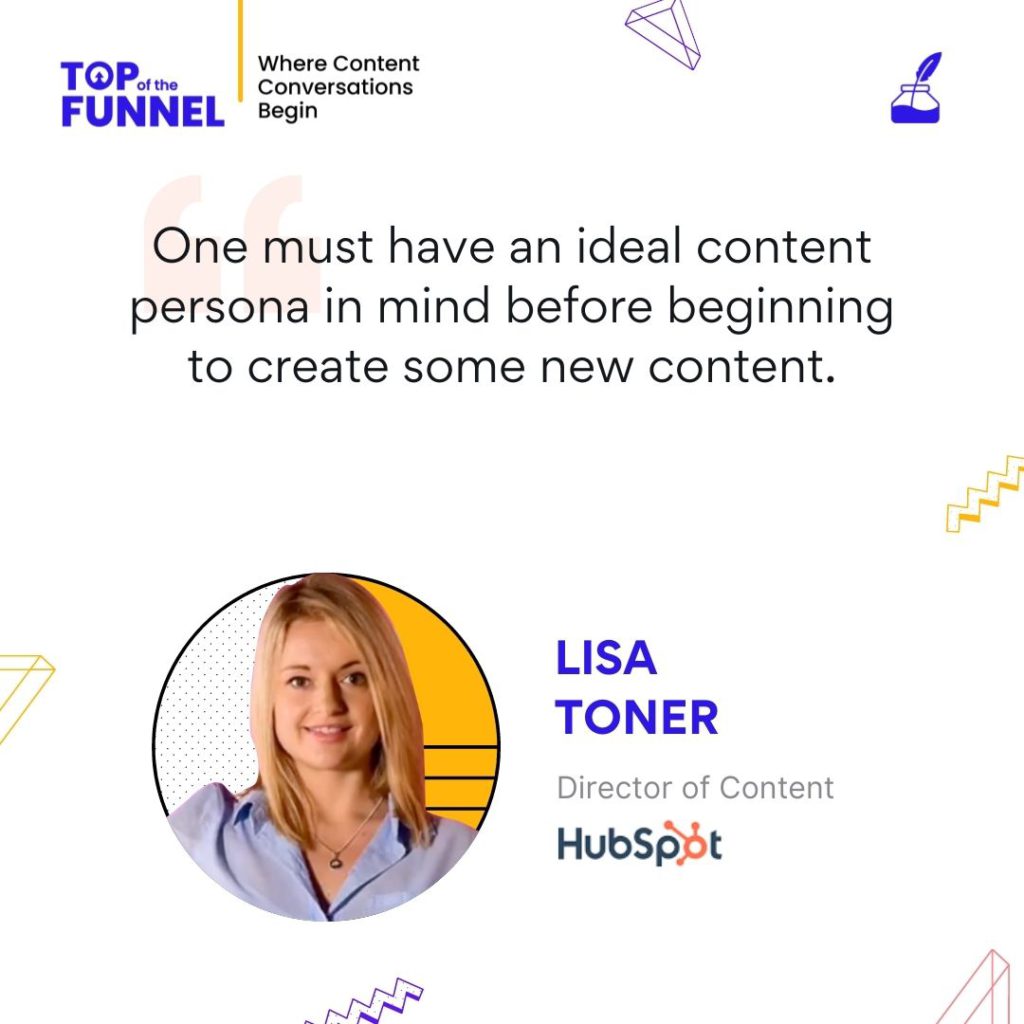
Natasha Puri: How can you drive user acquisition using content?
Lisa Toner: When I first started working on our sales persona and figuring out our content strategy, our sales persona was new. We had just launched our CRM. So, we were trying to drive users to sign up for the CRM. The first campaign that I ran was a sales process template, where I actually went to our head of sales and I said, “do you have any templates that you use for your team?”
And he gave me a one-page document on how to structure our sales process and showed me what a sales rep should be focused on at each stage in that process. I created a public-facing version of that, where people could come and download it. And within the download, which again was just a one-pager, people could see a link to include this in their CRM and operationalize it, which linked them to sign up for the free CRM. This was one of our most effective campaigns for driving users from a piece of content into a product. The other example is HubSpot academy.
Our academy is a library of free courses where people can learn the strategies of how to run and grow a business from an inbound perspective. Within the academy portal, they can search their courses, take the courses, and take their exams. We also have our product navigation, so that they can go in and explore to learn.
How do I actually apply what I’m learning here? Our courses are product agnostic, not talking about ourselves at all. Within software courses, we have practical exercises where we ask the learner to try certain things out. They can go into navigation and open up a tool and actually start to apply what they’ve just learned. So they’re now using our product without ever feeling like they were pushed to sign up for a product that they didn’t need. And then they see the value of it. This is one of our most effective ways of actually driving, not just customers because we have seen that people who take our courses before they sign up to pay for our product, actually have a higher sales price. They actually retain at a higher rate and stay with us for a lot longer.
They have seen the value of the product before they ever spent money on it. They didn’t feel like they were pushed into a sale they didn’t need. And now they’re equipped with the education on how to use the product, which makes them stay longer and get more value out of it. So it’s a really effective way to drive user acquisition from content.
Natasha Puri: HubSpot was one of the first players to have an academy. Fast forward to today, everyone is doing online courses, from individuals to brands. They’re all doing these online courses. What do you have to say about that?
Lisa Toner: During the pandemic, people either lost their jobs or went into remote workspaces. Availability of a lot of time gave people an opportunity to upskill or acquire a new skill. It is education mostly for free or for a very small price. And it is not going anywhere anytime soon. In fact, HubSpot courses are being offered now in some universities for credit. It is only going to get more and more credible. But, you can only be credible if you focus on what are you qualified to educate people on.
For HubSpot, we’re not gonna go and qualify people on how to build a car. We’re going to really niche on inbound topics. We are going to make sure that our content is the best out there for those topics. We spend months and months and months creating one course because the quality is so important to us and then we offer it for free. We have a really good, unique advantage that other course providers don’t. Some course providers are going for scaling. So they are getting as many courses out there as possible. But, we have so many rigorous steps in our process that it is quality approved at HubSpot.
Natasha Puri: I just have a final list of questions, which is the rapid-fire round. First question, long-form content or short-form content?
Lisa Toner: Short form content. We have such a small attention span right now, so the content has to be short.
Natasha Puri: Podcasts can help businesses with…
Lisa Toner: Connecting to their audience.
Natasha Puri: I would reject a guest blog if…
Lisa Toner: It was regurgitating the same content that I can find somewhere else.
Natasha Puri: Every content marketer is a writer, but every writer is not a content marketer, true or false?
Lisa Toner: True.
Natasha Puri: New course or new e-book?
Lisa Toner: New course.
Natasha Puri: Online events or offline events?
Lisa Toner: When it’s safe, offline.
Natasha Puri: The first word that comes to your mind when I say content marketing?
Lisa Toner: Creative.
Natasha Puri: The first word that comes to your mind when I say HubSpot?
Lisa Toner: Heart.
Natasha Puri: The first word that comes to your mind when I say Youtube?
Lisa Toner: Opportunity.
Natasha Puri: The first word that comes to your mind when I say Clubhouse?
Lisa Toner: Honest way out.
Natasha Puri: The first word that comes to your mind when I say remote work?
Lisa Toner: Comfortable.
Natasha Puri: The first word that comes to your mind when I say company culture?
Lisa Toner: Vital.
Natasha Puri: Thank you so much for doing this with us.
Latest Blogs
In this blog, explore the golden rules of using AI marketing tools so you can leverage the benefits to their maximum potential.
In this blog, you’ll learn how to avoid the pitfalls of SEO over-optimization while enhancing your site’s performance.
In this article, we’ll take a look at what AMP is, its advantages and disadvantages, and how it affects SEO.
Get your hands on the latest news!
Similar Posts
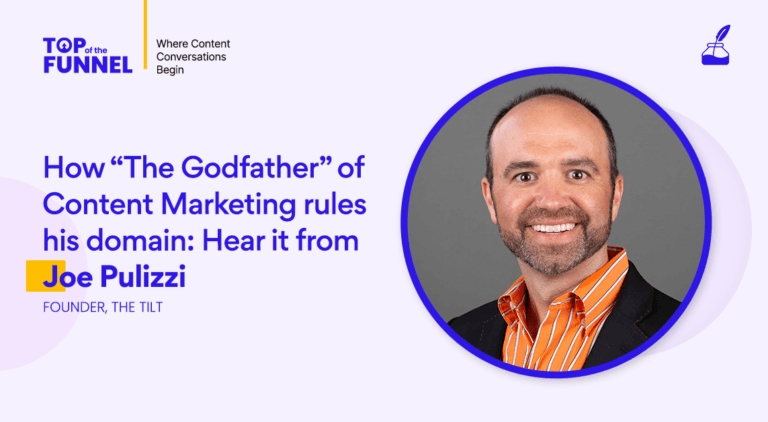
Expert Speak
18 mins read
Season 2 Episode #1 How “The Godfather” of Content Marketing Rules His Domain: Hear It From Joe Pulizzi
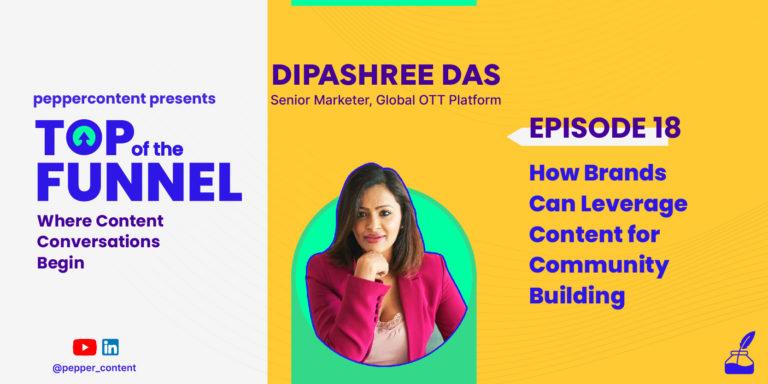
Expert Speak
16 mins read
Episode #18: How Brands Can Leverage Content for Community Building
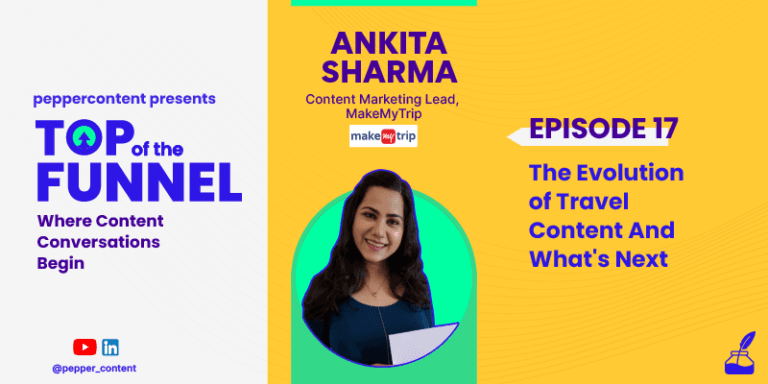
Expert Speak
11 mins read